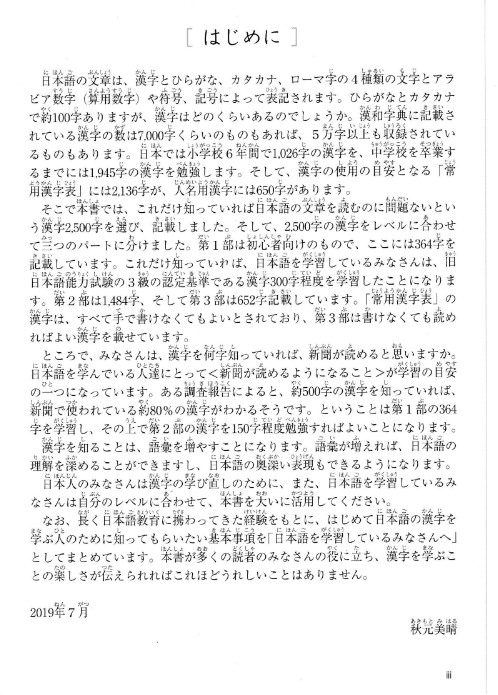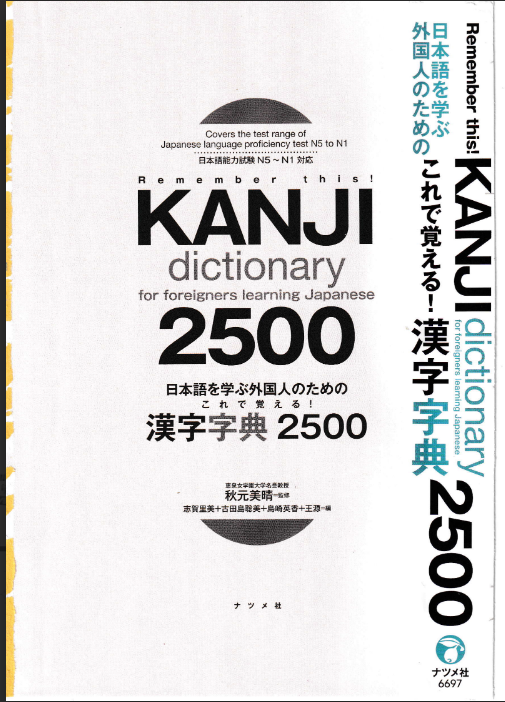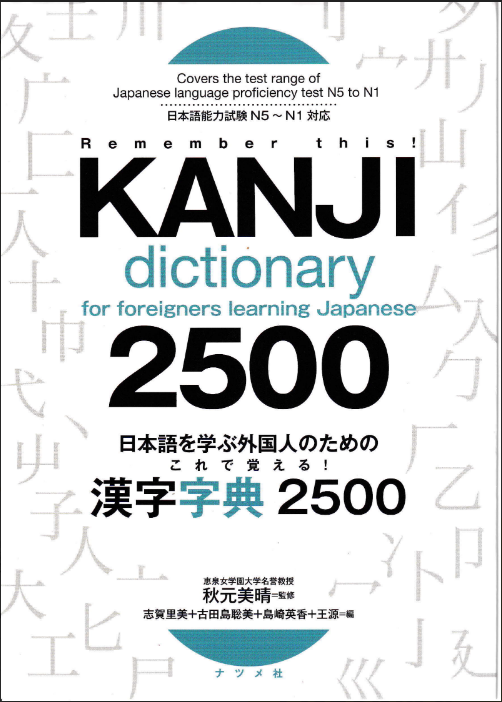


「はじめに」 日本語の文章は、漢字とひらがな、カタカナ、ローマ字の4種類の文字とアラビア数字(算用数字)や符号、記号によって表記されます。ひらがなとカタカナで約100字ありますが、漢字はどのくらいあるのでしょうか。漢和辞典に記載されている漢字の数は7,000字くらいのものもあれば、5万字以上も収録されているものもあります。日本では小学校6年間で1,026字の漢字を、中学校を卒業するまでには1,945字の漢字を勉強します。そして、漢字の使用の目安となる「常用漢字表」には2,136字が、人名用漢字には650字があります。 そこで本書では、これだけ知っていれば日本語の文章を読むのに問題ないという漢字2,500字を選び、記載しました。そして、2,500字の漢字をレベルに合わせて三つのパートに分けました。第1部は初心者向けの,<0xE3><0x80><0x80>こ<0xE3><0x80><0x80>こ<0xE3><0x80><0x80>に<0xE3><0x80><0x80>は<0xE3><0x80><0x80>364<0xE5><0xAD><0x97>を記載しています。これだけ知っていれば、日本語を学習しているみなさんは、旧日本語能力試験の3級の認定基準である漢字300字程度を学習したことになります。第2部は1,484字、そして第3部は652字記載しています。「常用漢字表」の漢字は、すべて手で書けなくてもよいとされており、第3部は書けなくても読めればよい漢字を載せています。 ところで、みなさんは、漢字を何字知っていれば、新聞が読めると<0xE3><0x80><0x80>思<0xE3><0x80><0x80>いますか。日本語を学んでいる人達にとって<0xE3><0x80><0x80>新<0xE3><0x80><0x80>聞<0xE3><0x80><0x80>が読めるようになることが学習の目安の一つになっています。ある調査報告によると、約500字の漢字を知っていれば、新<0xE3><0x80><0x80>聞<0xE3><0x80><0x80>で使われている約80%の漢字がわかるそうです。ということは第1部の364字を学習し、その上で第2部の漢字を150字程度勉強すればよいことになります。 漢字を知ることは、語彙を増やすことになります。語彙が増えれば、日本語の理解を深めることができますし、日本語の奥深い表現もできるようになります。 日本人のみなさんは漢字の学び直しのために、また、日本語を学習しているみなさんは自分のレベルに合わせて、本書を大いに活用してください。 なお、長く日本語教育に携わってきた経験をもとに、はじめて日本語の漢字を学ぶ人のために知ってもらいたい基本事項を「日本語を学習しているみなさんへ」としてまとめています。本書が多くの読者のみなさんの役に立ち、漢字を学ぶことの楽しさが伝えられればこれほどどうれしいことはありません。 2019年7月 狄元美晴
**この本の使い⽅** この本では役⽴つ2,500字の漢字を第1部・第2部・第3部の三つのパートに分けて掲<0xE3><0x80><0x80>載しています。 第1部は日本語を学習する⼈が、まず覚えておく<0xE3><0x80><0x80>と<0xE3><0x80><0x80>よい364字の漢字を「曜日」「数字」 「地形」「程度」「⾷⽣活」などのカテゴリー別に記載しています。 第2部は⽇常⽣活でよく使う1,484字を部首別に記載しています。 第1部と第2部の漢字は、書き⽅の順序がわかるように、筆順も紹介しています。 第3部は⽇常で⾒かける漢字なので、読めるようになりたいものの、書けなくてもあまり⽀障のない漢字652字を記載しています。 それぞれの漢字の欄に何が記されているのかを以下に説明します。 **第1部、第2部の漢字欄** (例:漢字「日」) ①漢字:漢字は学習しやすいよう、教科書体で記載しています。 ②部首:第2部、第3部の漢字は部首別に配列しています。同じ部首の漢字が並んでいますので、関連付けながら漢字を学習することができます。 ③画数:漢字の絵画的で面白い漢字の索引があります。第2部、第3部は部首の画数が少ないものから並べています。 ④簡体字:日本の漢字を中国で使う簡体字で示しています。 ⑤漢字の種別:その漢字が常用漢字の場合は「常用」、人名用漢字の場合は「人名」と記しています。 ⑥教育漢字:その漢字が教育漢字(小学校6年間で学習する漢字)に該当する場合は、暫学年を数字で表記しています。例えば、「⼩学1」とあれば、小学校1年生で習う漢字です。 9.訓<0xE3><0x80><0x80>音<0xE3><0x80><0x80>意味 9. ニチ、ジッ<0xE3><0x80><0x80> 字<0xE3><0x80><0x80>ひ、か<0xE3><0x80><0x80> 意味<0xE3><0x80><0x80>ひ。太陽。いちにち。ひとごと。日本の時。「日曜日」の略。 ●日帰り higaeiri one-day trip ●日の入り hinode sunrise ●日の入り hinori sunset ●日和 hiyori weather ●日曜日 nichiyoubi Sunday ●日光 nikkou sunlight ●毎日 mainichi every day ●来日 rainichi visit to Japan ●休日 kyuujitsu holiday / day off ★明日 ashita tomorrow ■日本 nihon – 日本 nippon Japan ⑤いつ日本へ来ましたか。10月3日に来ました。 When did you go to Japan? I went on October 3rd. 12. 曜日
[ Introduction ] Japanese language is written by 4 types of characters: kanji, hiragana, katakana and roman letters (ro-maji), in addition to Arabic numbers and symbols. In total, there are about 100 hiragana and katakana but can you guess how many kanji there are? Some of the kanji dictionary consists of about 7,000 kanji and others introduce over 50,000. In Japan the students are required to learn 1,026 kanji in their 6 years of elementary school and learn up to 1,945 kanji before graduating Junior High school. In addition, kanjo jyo kanji (commonly used kanji list) consists of 2,136 kanji and 650 jinmei (used in personal names) kanji. Therefore, in this book we have picked up 2,500 kanji so you won’t have difficulty when reading Japanese sentences. We have divided 2,500 kanji characters into 3 chapters according to its level. The first chapter consists of 364 kanji and it is good for beginners. For those who have started studying Japanese if you remember all of these kanji you will be able to pass the former level 3 Japanese-Language Proficiency Test. Chapter 2 consists of 1,484 kanji and chapter 3 consists of 652 kanji. It is said that you do not have to be able to handwrite all of the kanji which are shown in joyo kanji hyo so for the kanji in chapter 3, you do not have to remember the way to handwrite it will be enough if you can read them. By the way, do you know how many kanji are required to read the newspaper? “Being able to read the newspaper” is one of the standard for people studying Japanese. According to a research, if you know about 500 kanji you are able to understand 80% of the kanji used in the newspapers. Which means it will be enough if you remember the 364 kanji in chapter 1 and then study about 150 kanji shown in chapter 2. Learning kanji will increase your vocabulary skills. The more vocabulary you learn, the more deeply you will be able to understand Japanese and express in many different ways. Re-study kanji for those Japanese people using this book and for those who are studying Japanese make the best use of this book according to your knowledge. Based on my long experience of Japanese education, I have listed the basic rules for those who are studying kanji for the first time in “For those studying Japanese”. I could not be happier if this book is helpful for everyone and makes you realize learning kanji is fun. July, 2019 Miharu Akimoto — **Hình 2:** How to Use This Book This book consists of 2,500 useful kanji characters and is divided into 3 different chapters. The first chapter consists of 364 characters which you should remember as a start and is divided into categories such as “days”, “numbers”, “geographical features”, “degree”, and “eating habits”. Chapter 2 consists of 1,484 characters which is used frequently in daily life and is categorized by different radical. We have included steps of stroke order in chapters 1 and 2 so you can learn how to write them. Chapter 3 includes 652 characters which you will see in daily life so it is best to learn how to read them, but it will not interfere with your daily life even if you do not remember how to write it. The following information will provide you what is written in each kanji section. Chapters 1 and 2 kanji section [Image of Kanji 日 with associated text] Top Left Box: 日 (1) Below it: (4) Below it: (5) Below it: (7) Right of (1): (2) Right of (4): (8) Right of (5): (9) Right of (7): (10) Right of (2): (3) Right of (8): (11) Right of (9): (12) Below (3): きょう kyou today Below (11): にち nichi day Below (12): ひ hi day Bullet points next to the character: ● 日曜日 higari- day trip ● 日にち nichi- Sunday ● 平日 hiruhi- weekday ● 毎日 mainichi- every day ● 休日 kyūjitsu- holiday / day off ● 日本 nihon – Nippon day ● 日本へ行きましたか。 10月3日(日) Nihon e ikimashita ka. 10 gatsu 3 nichi (nichi). When did you go to Japan? It was on October 3rd. Right side of character: ● 日の出 hinode – sunrise ● 日の入り hiri – sunset ● 日光 nikko – sunlight ● 明日 ashita – tomorrow ● 明日 asa – morning Numbered explanations: ① Kanji: The kanji (日) is shown in a font used in common textbook to make it easy to study. ② Radical: The radical is shown. Chapters 2 and 3 are arranged by the radical. Characters which use the same radical are shown alongside so you will be able to learn them by its connection. ③ Number of strokes: Shows number of strokes used in each character. Chapters 2 and 3 are in order of number of strokes required in each radical. There is an index at the end of the book arranged in the order of total number used for radical strokes. ④ Simplified Chinese character: The kanji is shown in simplified Chinese character equivalent. ⑤ Kanji classification: Marked with 常用 (joyo) if the character is listed in the joyo kanji hyo and with じんめい (jinmei) if the character is not included in joyo kanji hyo but used for personal names. ⑥ Kyoiku (注訓 education) kanji: If a character is taught in elementary school, it is marked as (小). — **Hình 3:** gaku) plus the school year in which the character is taught. For example, if the character has 「小」 学 as part of its components, it means it is taught in the first grade of elementary school. ⑦ Kanji Test: Showing its grade of The Japan Kanji Aptitude Test in numbers in which the character is tested. ⑧ Japanese-Language Proficiency Test: Showing its level in the former Japanese-Language Proficiency Test. Although the current Japanese-Language Proficiency Test, kanji are not based on topic, so the old Japanese-Language Proficiency Test standards have been followed. Former test level 4=N3, former test level 3=N4, former test level 2=N2, 3, the former test level 1=N1. ⑨ On reading: Shows the on reading of the kanji by katakana followed by roman letters (romaji). The romaji is spelled in Hepburn romanization but for long pronounced sound we have shown the closest pronunciation so it is easier to use. ⑩ Kun reading: Shows the kun reading of kanji. Conjugational kana ending is separated after – (hyphen) and both of them are followed by roman letters. ⑪ Meaning: Showing its simplified meaning. ⑫ Stroke order: Shows the stroke order used to write kanji. It is divided up to 8 parts and when writing start from left to right. ⑬ Words: Show words that use the particular kanji after 「★」. Jukujukun (set of 2 or more kanji characters read by kun reading) is shown by ★. The words are listed as follows: kun reading comes first, then on reading and finally jukujukun. All of the words have roman letters (romaji) to show how to read and also simple translation into English. ⑭ Example sentences: Examples of the particular kanji used in a sentence. The words used in the sentences are marked with ■. ⑮ Sentence types: 「…す・ます」(desu・masu) and 「…だ・である」(da・dearu) are two different ways to make a Japanese sentence. It is better to get used to both ways since in daily occasions. 「…ます」(desu・masu) is mainly used when speaking or writing letters and 「…だ・である」(da・dearu) is often used in literary style such as newspapers or thesis. So to understand both types, in this book the sentence using 「…ます」(desu・masu) is marked with ■ and sentence using 「…だ・である」(da・dearu) is marked with ●. All of the sentences shown in chapter 1 are marked with ■. Chapter 2 consists of both types of sentences so you will be able to learn the 2 different types. Chapter 3 kanji section [Image of Kanji 後 with associated text] Top Left: 後 (1) Below it: (4) Below it: (5) Below it: (7) Right of (1): (2) Right of (4): (8) Right of (5): (9) Right of (7): (10) Right of (2): (3) Right of (8): (11) Right of (9): (12) Below (3): のち nochi later Below (11): ご go late Below (12): うしろ ushiro behind Next to the character, with numbers: 14: Example sentences ● 後で (ato de) later ● 後ろ (ushiro) behind ● 後の (no ato no) after ● 後ろの方 (ushiro no hō) the rear part ● 日本へ行くのは、後で (Nihon e iku no wa, ato de) Going to Japan is later. ● 後で、電話します。(Ato de, denwa shimasu.) I will call you later. ● 後ろに、彼は立っています。(Ushiro ni, kare wa tatte imasu.) He is standing behind. ● 後で、映画を見ます。(Ato de, eiga o mimasu.) Later, I will watch a movie. Right side, with numbers: 13: Meaning ● 後 ko – go (after, later, back) ● 後 ko – go (empress) ● 後 ko – go (later) ● 後 ko – go (empress) ● 後 ko – go (later) ● 後 ko – go (empress) 13: Meaning ● 後 ko – go (after, later, back) ● 後 ko – go (empress) ● 後 ko – go (later) ● 後 ko – go (empress) ● 後 ko – go (later) ● 後 ko – go (empress) 13: Meaning ● 後 ko – go (after, later, back) ● 後 ko – go (empress) ● 後 ko – go (later) ● 後 ko – go (empress) ● 後 ko – go (later) ● 後 ko – go (empress) Below number 6: Kyoiku (教育) kanji 「後」: ‘Later’ can be taught in elementary school. The kanji character after the text is “後”. Below the character, with numbers: 5: Kanji classification 常用 (joyo) 7: Kanji Test The grade is shown as 3. 9: On reading こう (kō) ご (go) 10: Kun reading のち (nochi) うしろ (ushiro) 12: Stroke order The stroke order diagram is shown. Below the main section, a paragraph: Kanji shown in chapter 3 are characters which are best to learn how to read them but it will not interfere with your daily life even if you do not remember how to write it. Each section is reduced so we can fit in as many characters as possible. The contents shown are the same as ①, ③, ⑤, 11, and ③ of chapters 1 and 2.


